What is Hindutva?
Hindutva, a centuries-old concept, is today a growing phenomenon in India and the South Asian region, redefining the country’s domestic politics, behaviour in the international community and its outlook on its citizens, and the region’s alliances, political dynamics, and geopolitical structure.
This research paper aims to acknowledge the rise of conservative Hinduism in India as an alarming reality and not just a matter of domestic concern. It also analyses the emerging threats associated with the rise of Hindutva in India and its regional neighbor, South Asia, which is the core research problem of the paper.
For that purpose, India’s national policies for its natives and its regional approach towards its neighbours are proximately and critically analyzed to observe how Hindutva is reshaping India’s attitude. Secondary methods, i.e., articles, journals, newspapers, research papers, books, etc., have been consulted to accumulate data for the research.
The scope of the research is academic in terms of covering the loopholes of the previous research and laying the foundation for future research, as well as practical in highlighting the real-time consequences and implications of the problem.
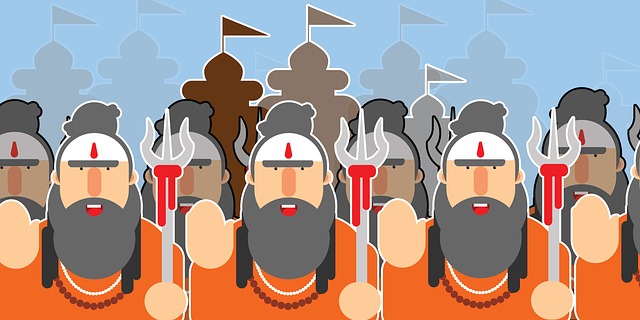
The paper concludes that Hindu nationalism, initially initiated to amalgamate the Hindus, has now changed into an assailant rendition that forces the Hindu religion and way of life over different organizations and minorities.
However, much as it compromises the harmony and strength of the country, it also undermines territorial coordination. It would cause serious repercussions provided no collective stance is taken by the international community and the Indian citizens to bottle the extremist nationalism.
Introduction
Problem Statement
Hindutva, also often regarded as Hindu Nationalism, is an ideology followed by the conservative Indian natives, which preaches the hegemony and dominance of the Hindu religion, its culture, and lifestyle, not just in India but the entire subcontinent, from Afghanistan to Indonesia.
It revolves around the principles of establishing a “Hindu Rashtra” (Hindu Nation) in the South Asian region, revenging the oppression faced by Hindus by the Muslim and Christian rulers in the historic context by treating the non-Hindu Indian natives as second-class citizens, and transforming India from secularism to traditional and conservative religion.
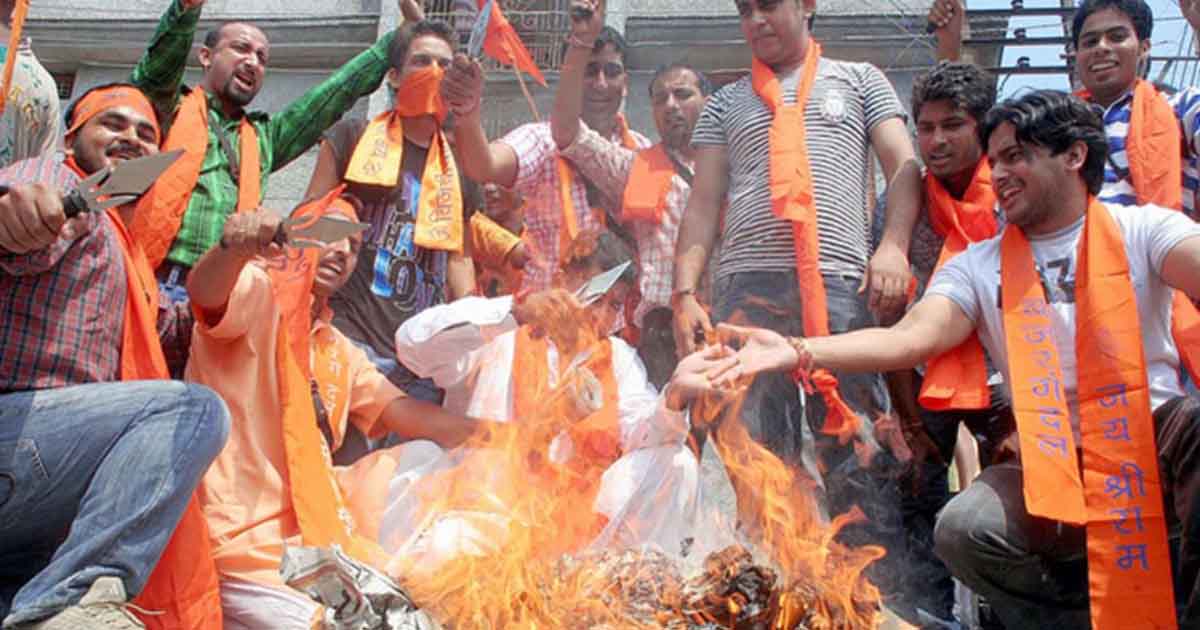
This ideology has evolved, developed and adapted to the changing political and societal norms for 74 years and has today reached a position where it is not only convincingly threatening the Indian secular and diverse principles; which have long been prized and celebrated by India; through Modi’s extremist and antagonistic policies, dictating internal and external Indian politics based on fanaticism and radicalism, but is also shaping regional and international security.
Objectives and Limitations
The objective of this study is to officially recognize Hindutva as an emerging threat to national, regional, and global peace and not undermine the severity of the issue by labeling it as a domestic concern.
For this purpose, the paper argues for a closer look at Modi’s two eras of authoritarian regimes in 2014 and 2018, to observe his harsh policies through the lens of Hindutva ideology and identity and to analyze how Modi is performing his role as a Hindutva ambassador while being the administrative head of one of the most diverse and powerful democracies.
The paper also aims to analyze the secular and diverse underlying guiding principles through which Nehru laid the foundation of a tolerable and accepting India and the principles that Modi is putting forward to bring about an aggressive and conservative India. The focus of the study is only on India and the South Asian region, which restricts the research within the given parameters.
The research paper will neither deal with the successes the Modi administration has achieved in their rules, as they have fairly and over-exaggeratedly been discussed by the Indian media, nor with Modi policies other than those reflecting Hindu elements, as that would detract from the research’s main purpose.
While conducting the research, placed posed other questions than the thorough research needed to address my questions. The topic is being recognized currently, and research is regulated slowly and gradually.
Significance
The area of the research paper is kept within the bounds of how Hindutva is emerging as a national, regional, and international security concern for the global community and how Hindutva is undermining the profane basis of the Indian state and society.
The study is limited to specific regions to justify the topic within the given time frame with much analysis and research and not to add unnecessary arguments to make the reader lose interest.
Academically, such a research paper will open the door to many other opportunities for researchers willing to analyse Hindutva as a problematic phenomenon in national, regional, or international contexts.
It provides an insight into how Hindutva ideology and culture are damaging the core Indian principles of equality, diversity, and secularism, and that is why this paper can further be the basis of research on the global recognition of the roots, evolution, and implications of Hindutva as an ideology of the world’s biggest democracy. Practically, it will be of paramount importance.
Firstly, it will portray the true nature of Hindutva beliefs and reflect how the Bhartiya Janata Party (BJP) and Narendra Modi exploit Indian constitutional laws and its citizens to ensure the religious belief of Hindu hegemony.
Secondly, it will help the readers analyse the core importance of this emerging threat and awaken the human rights champions worldwide to break their silence against the inhumane treatment of non-Hindu Indian citizens.
Thirdly, it will indicate the policy options for India and other South Asian states to deal with the current security dilemma created by Modi’s fascist Hindutva policies.
Fourthly, it will also show that if the concerns are not timely addressed, what repercussions can they bring for India and South Asia?
Historical Background
Some analysts claim Hindutva to be a contemporary phenomenon resulting from Muslim militancy. However, this claim can be denied by highlighting the Arya Samaj Movement in 1875 and the concept of Hindu-ness it introduced.

Arya Samaj was the first movement of its kind that encouraged Hindu nationalism and even introduced proselytization in Hinduism. Later, in the early half of the 20th century, social activists associated with Arya Samaj debated a meritocratic caste system to revive the Hindu identity, which was somehow refused.
Hindu nationalism then stood on more strict and conservative principles, i.e., the explicit divisions between Hindus, Muslims, and Christians.
It further led to the printing of a pamphlet in 1923 named “Essentials of Hindutva”, which later came to be known as “Hindutva: Who is a Hindu?” by Vinayak Damodar Savarkar, who, in his text, called out the Muslims and Christians as non-Indian entities and defined a Hindu by explaining the core of Hinduism and putting forward four principal criteria for Hindu identity :
- A legitimate Hindu is geographically a citizen of India.
- A legitimate Hindu shares the same race and common blood as that which ran through the veins of Ram, Krishna, Buddha, Mahavir, Nanak, Chaitanya, and other religious forefathers.
- A legitimate Hindu owns and practices Hindu civilization (Sanskrit language) as a whole.
- A legitimate Hindu looks upon India not only as his motherland or fatherland but also as the Holy Land.
Two years later, in 1925, a Brahmin Hindu, Keshav Hegdewar, founded the militant Hindu organization, the Rashtriya Swayamsevak Sangh (RSS), arguing that an independent India should be a state for Hindus.
Hedgewar added two new pillars to traditional nationalism: Sangathan (Hindu organization) and Seva (service). In the 21st century, the Sangathan tenet in Hindutva has evolved and led to the creation of the Sangh Parivar, which translates into the Family of Associations.
“The Sangh Parivar is a network of Hindutva organizations with the same ideological goal of implementing the Hindutva agenda and often overlapped membership that gravitates around the RSS.” (Falak, J.).
It comprises approximately 52 associated organizations covering educational, political, social, and intellectual fields with a vast interwoven network locally and globally. The highlighted groups of the Parivar are:
- Bhartiya Janata Party, BJP (the political wing).
- Rashtriya Swayamsevak Sangh, RSS (the militant wing).
- Vishwa Hindu Parishad, VHP (the religious youth wing).
- Akhil Bharatiya Vidyarthi Parishad, ABVP (the student’s coalition wing).
- Bajrang Dal (the militant religious wing).
- Vivekananda International Foundation, VIF (a think tank that sponsors and supports terrorism in the Indian neighbourhood).
Other than the Sangh Parivar, Hindu nationalism is promoted through other entities:
- Local Allies: local political groups alliance with Sangh Parivar for vested interests, e.g., Shiv Sena and Sanathan Sanstha.
- Splinter Cells: those groups fully follow the Hindutva ideology but are against the RSS hegemony in Hindu nationalism, e.g., Abhinav Bharat.
- Lone Wolf- a person who conducts terrorist activities in compliance with the ideology but without any support from particular organizations and groups and on his own, e.g., Gopal Godse and Nathuram Vinayak Godse, both guilty of murdering Mahatma Gandhi.
- A legitimate Hindu is geographically a citizen of India.
- A legitimate Hindu shares the same race and common blood as that which ran through the veins of Ram, Krishna, Buddha, Mahavir, Nanak, Chaitanya, and other religious forefathers.
- A legitimate Hindu owns and practices Hindu civilization (Sanskrit language) as a whole.
- A legitimate Hindu looks upon India not only as his motherland or fatherland but also as the Holy Land.
Through its interconnected networks and aggressive objectives, Hindu nationalism has fully progressed into “Militant Hindutva.” It actively engages in terrorist activities against non-Hindus (especially Muslims and Christians) and lower-caste Hindus.
A recent phenomenon called “Saffron Terrorism” has emerged to indicate the terror-spreading activities of Hindutva organizations. The widely known incidents of Saffron terrorism include the assassination of Gandhi by Gopal Godse (1948), the Gujarat Riots of 2002 (initiated by Modi), the Samjhauta Express Bombings (2007), the Mecca Masjid Bombings (2007), the Ameer Dargah attacks (2007), etc.
Due to its fanatic and radical ideology and inhumane activities, Hindutva in India has become a bigger threat than any other terrorist group.
Theoretical Framework
The constructivist lens can provide a better understanding of the Hindutva phenomenon and its underlying rationale. Constructivism asserts that state behaviour in the international system is neither driven by selfish human nature (realism) nor by the anarchic international system (structural realism).
However, the determinant of state behaviour is the different images of reality that states perceive. They tend to argue that “there is no such thing as absolute reality”. State perceptions of reality are based on assumptions and perceptions (Wendt).
These perceptions and images are based on a state’s culture, history, identity, language, values, ethnicity, etc., and are socially constructed through interactions with other states.
Analysing Hindutva through this perspective, it can say that the aggressive and harsh approach of Hindus against Muslims and Christians has been socially constructed through interaction with these communities over time.
Since Muslims have ruled over the Hindus for over six centuries through empires and dynasties and Christians ruled over them as their colonial masters, the resentment against both communities tends to be generated from these historic experiences.
Similarly, the Hindu Maurya dynasty, ruled by Chandragupta Maurya, is regarded as the most successful Hindu empire. The desire to repeat those achievements was socially constructed in the shape of the Hindutva ideology.
These identities and values establish state interests and behaviour, and simultaneously, the interests and actions of states tend to align with their identities. Wendt, in this regard, argues that “identities tend to shape who states are and interests mention what they want, so without telling who the states are, we cannot judge or presume what they want, and since identities involve cultural content, so do state interests.”
Wendt also argues that the state’s interests are of two main types: subjective and objective. Subjective interests include the reproduction of the four types of identity, and objective interests include those underlying beliefs of states on how to achieve their goals. Subjective goals are much closer to determining state behaviour.
Hence, India’s national interest can comply with its subjective interest as it continues to dictate policies to achieve identity aims.
Antagonistic Indian policies towards Pakistan, its vile attitude toward the Muslim and Christian minorities, its urge to dominate the region and compete with China, its inclination to expand its territory, and its actions to promote the Hindi language, lifestyle, and culture can therefore be studied under the light of its religion and can be rationalised that way.
Indian Secularism and Hindutva
The driving force behind the partition of the subcontinent in 1947 was the marginalisation of non-Hindu ethnic, religious, and linguistic groups, especially Muslims.
To understand the dynamics of plurality and multi-ethnicity in Indian society and to avoid future strife similar to that of the Two-Nation Theory, the founding fathers of India, Jawaharlal Nehru and the Indian National Congress, brought forward the concepts of “Secularism” and “Unity in Diversity” post-independence.
Jeremy Rodell defines secularism as “institutional separation, freedom of belief, and no discrimination on the grounds of religion.” This was the rationale behind Nehru’s Secularism. Secularism is to keep all the communities of India intact and steer clear of religious fanaticism and bigotry.
Hence, it was more of a political move than a social one. The move was successful in the initial periods of the 1960s and ’70s and also incorporated secular views into the Indian Constitution in 1949.
Still, ever since the Hindu-Muslim riots and tensions escalated in the 1990s, the BJP cashed in on those situations, and its militia wings, the Bajrang Dal, VHP, and RSS, have further fueled the rivalry to gain political benefits.
They succeeded, but with their success came the downfall of Indian multi-religiosity and secularism. Secularism and Hindu Democracy were the main highlights of Indian Democracy worldwide. The last nail in the coffin of Indian liberalism and pluralism has proved to be Modi’s fascist and authoritarian regime since 2014.
It has made India one of the most religiously, ethnically, and linguistically suffering nations where minorities are not safe. The following is an overview of the policy shifts taken by the BJP government to make India one of the most dangerous countries in the world to live as a minority.

Under Modi and the BJP’s influence, India has gone way too far in Islam’s hatred and enmity. Ever since they were in power, their policies were driven by the desire to suppress Muslims in every possible way and to make them leave India.
The rightist wings of Sangh Parivar have been deployed to bring harm, torture, and trouble to the Muslim community, as they are the largest minority community in India and, as per their thoughts, “a threat to Indian Nationalism”.
Similarly, the Hindu Maurya dynasty, ruled by Chandragupta Maurya, is regarded as the most successful Hindu empire. The desire to repeat those achievements was socially constructed in the shape of the Hindutva ideology. These identities and values establish state interests and behaviour, and simultaneously, the interests and actions of states tend to align with their identities.
Wendt, in this regard, argues that “identities tend to shape who states are and interests mention what they want, so without telling who the states are, we cannot judge or presume what they want, and since identities involve cultural content, so do state interests.” Wendt also argues that the state’s interests are of two main types: subjective and objective.
Subjective interests include the reproduction of the four types of identity, while objective interests include those underlying beliefs of states on how to achieve their goals. Subjective goals are much closer to determining state behaviour. Hence, India’s national interest can comply with its subjective interest as it continues to dictate policies to achieve identity aims.
Antagonistic Indian policies towards Pakistan, its vile attitude toward the Muslim and Christian minorities, its urge to dominate the region and compete with China, its inclination to expand its territory, and its actions to promote the Hindi language, lifestyle, and culture can therefore be studied under the light of its religion and can be rationalised that way.
Modi’s First Tenure (2014-2019)

Modi’s first tenure was driven by the aim of introducing a new version of Hindu Nationalism in India, following the vision and version of RSS, and his policies reflected that.
Hindutva-driven groups and organisations
The influence of Hindutva-driven groups and organisations in the government can be witnessed from the first step of framing the Prime Ministers’ Cabinet, which was formed of 9 members from RSS.
Many State Ministers were also associated with ABVP (Akhil Bharatiya Vidyarthi Parishad), the student wing of Sangh Parivar, Modi’s National Security Advisor (NSA), Ajit Doval, has been in alignment with RSS ever since, and also his son, Shaurya Doval, initiated a think-tank called India Foundation, which is the keystone behind BJP’s policies.
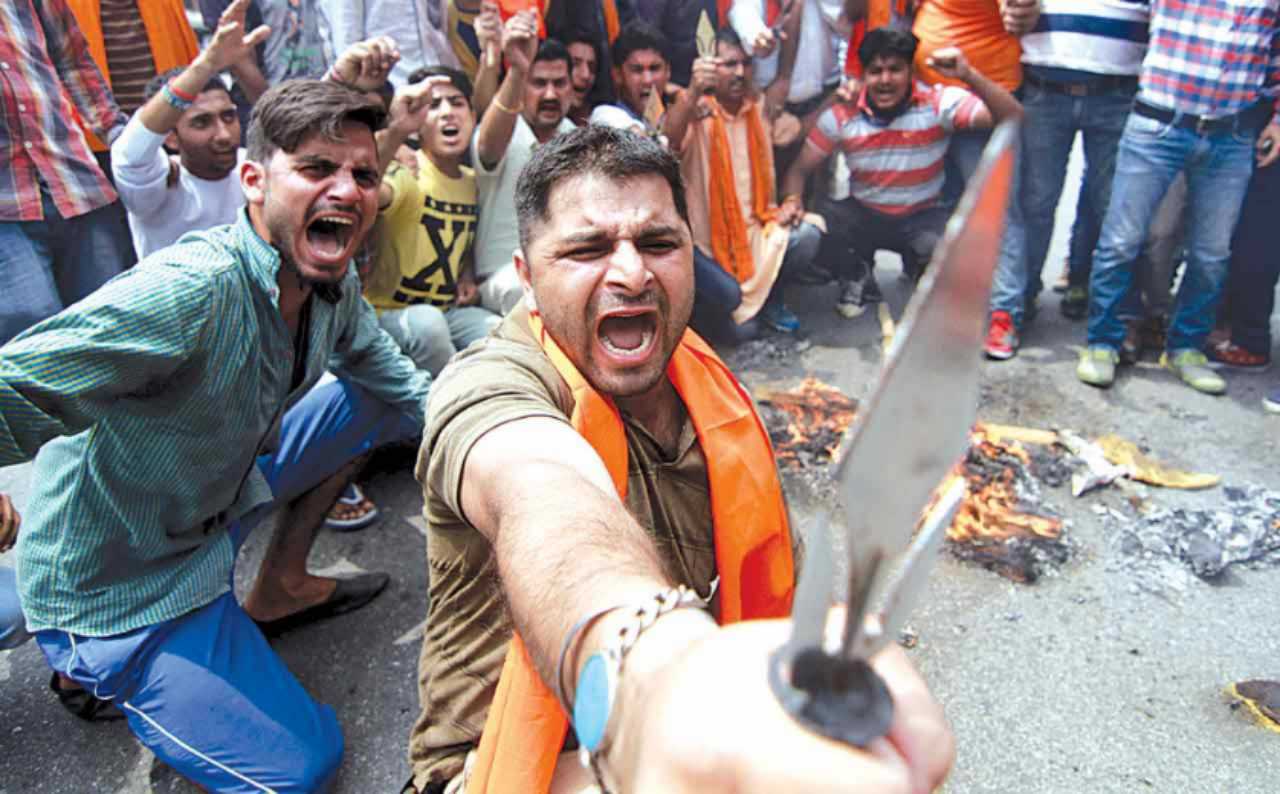
Therefore, Hindutva has been interwoven into the fabric of the BJP government since 2014 and has now become an inseparable part of the government and its policies.
Bajrang Dal
Bajrang Dal, a right-wing militia group of Sangh Parivar, which had been banned or abandoned for the last thirty years due to its involvement in religious terrorist activities, e.g., the demolition of Babri Masjid in 1992, Akhadas in 2005, etc., was revamped and legitimised by the Modi government on a priority basis.
Not just this, but they were granted legal protection in cases against them, and not a single activist has been sentenced in any case during the whole time frame. They were celebrated in their camps as nothing less than able to eradicate Muslims from the country.
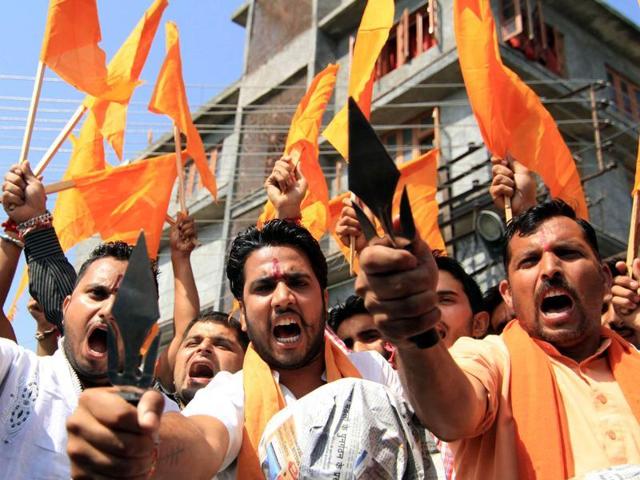
During his first tenure, there was a 28% spike in violence and brutality based on religious differences (against Muslims and Christians, most of which are not even reported) planned by Bajrang Dal, Shiv Sena, VHM etc.
A report by UK-based MRG mentions that in 2017 alone, more than 700 outbreaks of communal violence occurred in India that killed 86 and injured 2,321 people. The actual number, however, could be higher as many cases go unreported (Bhomick, N., 2019).
Bhonsala Military School
The militant Hindutva wings have also established military schools for the training of men and women to prepare them “for the game of killing masses of men with the ambition of winning with the best possible causalities (sic) of dead and wounded while causing the utmost possible damage to the adversary.” (Islam, S.2018).

The Bhonsala Military School (BMS) hires retired army personnel to train the young male population and has expanded at an escalating rate since the first Modi period. One trained batch of BMS, called “The Shadow Army”, has been specifically trained to organise mobs and use modern arms and weaponry under the banner of “Defensive Violence”.
In an interview, Bal Thackery, the institutor of Shiv Sena, said, “Islamic terrorism is growing, and countering it with Hindu terrorism is the only way to counter it.” ” We need suicide bomb squads to protect India and Hindus” (News 18, 2009).
Similarly, for women, a Durga Vahini (Durga Army) named school has been established to train them for combat and violence and also inculcate anti-Pakistan hatred feelings among the trainees. One of their official slogans is, “Hindustan is for Hindus.” Pakistan can go to hell! ” (BBC, 2014).
In 2016, a group called “Hindu Swabhiman” set up training camps for preparing children as young as 8 for armed conflicts and a Holy Army (Dharma Sena) to counter war forces in India and take control of Uttar Pradesh.
Gau Raksha (cow protection) movement
The Gau Raksha (cow protection) movement gained much notoriety in the initial years of the Modi era. The Bhartiya Gau Raksha Dal, a nationalist group associated with the RSS, tortured and killed many cattle transporters (mainly Dalits) by accusing them of smuggling cows.
The so-called protectors have been actively involved in “cow terrorism,” especially against Muslims and Dalits, in Haryana, Maharashtra, Rajasthan, Madhya Pradesh, and Gujarat, and took no action against them. Instead, cases were made against the victims’ families. The perpetrators were granted impunity, which provided them with more room to threaten the lives and property of the minorities.
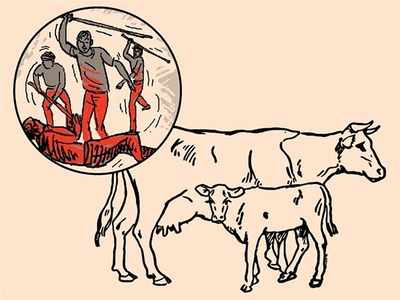
One hundred sixty-eight (168) cases were reported of cow terrorism against the militants of Bhartiya Gau Raksha Dal, including Mohammad Akhlaq, UP; Pehlu Khan and Ummar Khan, Rajasthan; Mazlum Ansari, Imteyaz Khan, only 15 years old. And Alimuddin in Jharkhand; Inspector Subodh Kumar Singh, UP.
Civil activists who worked for the rights of Dalits and Adivasis and critics of the government were detained, put into jail, and accused of planning to kill the Prime Minister, including Sudha Bharadwaj, a lawyer turned activist, who was jailed for defending the rights of the Dalit community; Narendra Dabholkar, an activist, author, and a critic of the BJP government; Govind Pansare, a bold critic of Hindutva and BJP policies; M.M. Kalburgi, a scholar and author; Gauri Lankesh, a news reporter, journalist, and a daring critic of Modi authoritarianism, and the list can go on and on.
Anti-Conversion Law
The BJP government has passed an “anti-conversion law” which makes it illegal for Hindus to convert to Islam or Christianity. This law has been used as an excuse and justification by the militant wings of RSS to target Muslims and other minorities. For example, in 2016, in Uttar Pradesh, the Bajrang Dal intentionally blamed a worker for persuasively changing Hindus to Christianity, shaved his head, and strutted him through town on a donkey.
Under Modi and the BJP’s influence, India has gone far in Islam’s hatred and enmity. Since they were in power, their policies were driven by the desire to suppress Muslims in every possible way and make them leave India.
A Threat to Indian Nationalism
The rightist wings of Sangh Parivar have been deployed to bring harm, torture, and trouble to the Muslim community, as they are the largest minority community in India and, as per their thoughts, “a threat to Indian Nationalism”.
Similarly, the Hindu Maurya dynasty, ruled by Chandragupta Maurya, is regarded as the most successful Hindu empire. The desire to repeat those achievements was socially constructed in the shape of the Hindutva ideology. These identities and values establish state interests and behaviour, and simultaneously, the interests and actions of states tend to align with their identities.
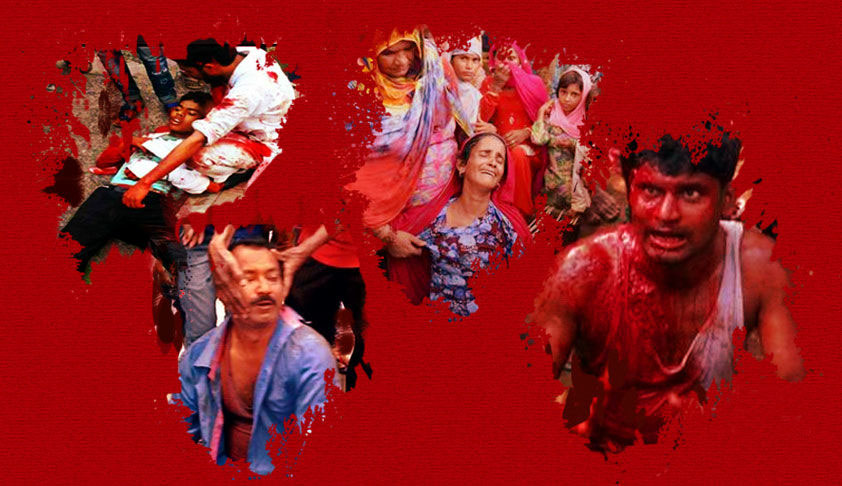
Wendt, in this regard, argues that “identities tend to shape who states are and interests mention what they want, so without telling who the states are, we cannot judge or presume what they want, and since identities involve cultural content, so do state interests.” Wendt also argues that the state’s interests are of two main types: subjective and objective.
Subjective interests include the reproduction of the four types of identity, while objective interests include those underlying beliefs of states on how to achieve their goals. Subjective goals are much closer to determining state behaviour. Hence, India’s national interest can comply with its subjective interest as it continues to dictate policies to achieve identity aims.
Antagonistic Indian policies Towards Pakistan
Antagonistic Indian policies towards Pakistan, its vile attitude toward the Muslim and Christian minorities, its urge to dominate the region and compete with China, its inclination to expand its territory, and its actions to promote the Hindi language, lifestyle, and culture can therefore be studied under the light of its religion and can be rationalised that way.
The Second Tenure of Modi
The first Modi era concentrated on constructing a new type of Indian nationalism. The second tenure, however, is expansionist and aims to take another step towards establishing Hindu Rashtra or maybe has even reached there, which Modi has comprehensibly dictated through his government policies.
The Abolishment of Articles 370 and 35(A)
The abolition of Articles 370 and 35(A) from the Constitution, which is not just a violation of the Indian Constitution itself but a United Nations Security Council Resolution as well, is one of the most ruthless policies of the BJP and Narendra Modi and a clear indication of the fascist and expansionist policies of India. By eliminating the special status of Indian-occupied Kashmir along with the initiation of strict curfews and hundreds of thousands of RSS and Indian Army soldiers, the house-arrest of separatist leaders, blockades on communication throughout the state, and the introduction of a new political map of India, which also includes some disputed Nepali regions in Indian territory, India is giving the indication that India is no longer a secular state but, an authoritarian Hindu nation-state.
Love Jihad Law
Inter-religious marriages were a common practice in India until the secularist forces prevailed. Still, the extremist and militia wings of the Sangh Parivar, the RSS, Bajrang Dal, and VHS, have introduced the concept of “love jihad.”
In which they accuse Muslim men of marrying Hindu women with the sole purpose of converting their religion. Under this assumption, they tortured, killed, and harassed many Muslims and Hindus who wanted to marry someone from another religion.

Considering it as propaganda, the BJP government passed a “Love Jihad Law” in 2019 in Uttar Pradesh, prohibiting inter-faith marriages and enforcing strict punishment on those trying to do so. The main motive behind this law is to prevent Muslim men from marrying Hindu women, as Islam makes it essential for non-Islamic people to first convert to Islam and then marry.
Citizenship Amendment Act of 2019
The Citizenship Amendment Act of 2019 and the National Register of Citizens (2019) were other pearls in the string of anti-Muslim sentiments. This biased law marginalizes Muslims by accommodating and giving asylum to non-Muslim refugees but disallows Muslim refugees from being granted citizenship or entering India.
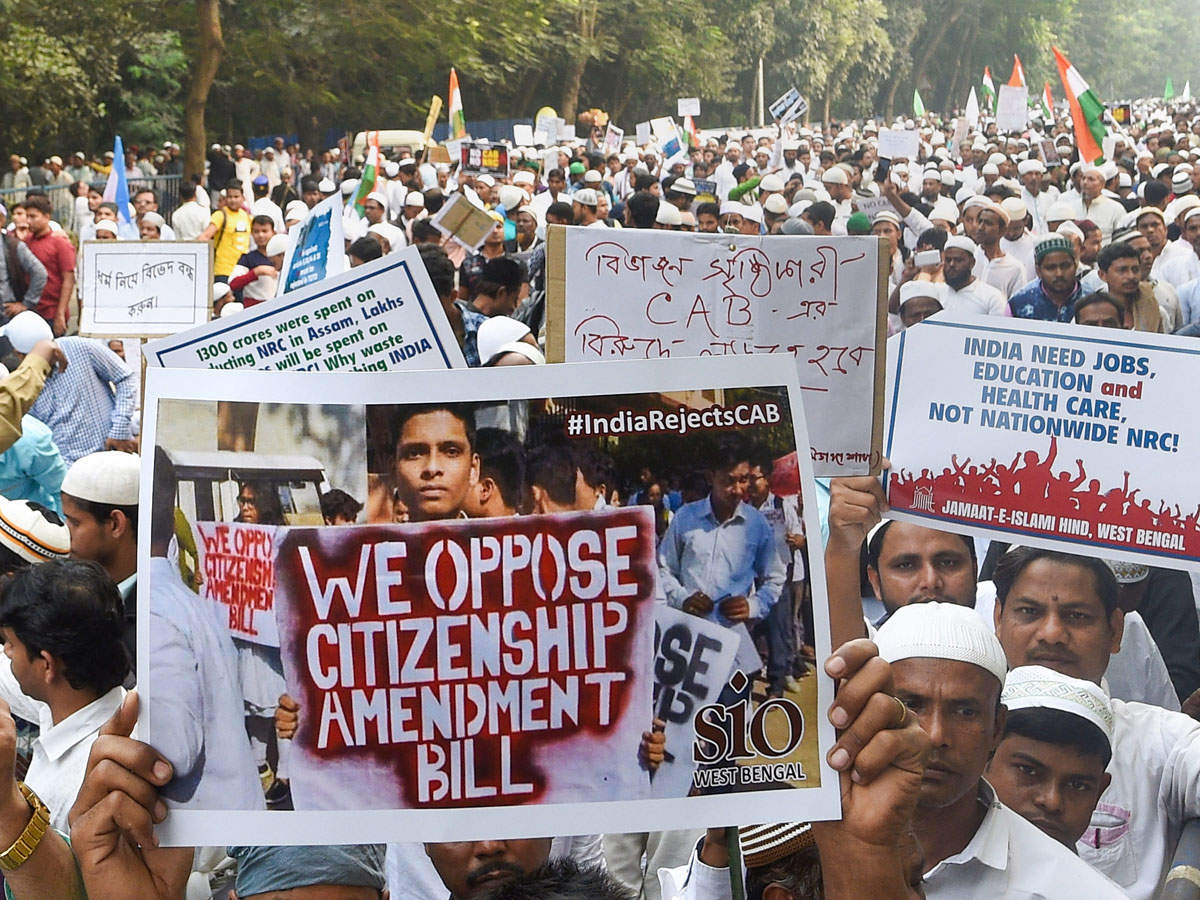
The wave of criticism it received was due to the harm it inflicted upon the constitutional articles. Delhi-based lawyer Gautam Bhatia says that by dividing alleged migrants into Muslims and non-Muslims, the bill “explicitly and blatantly seeks to enshrine religious discrimination, contrary to our long-standing, secular constitutional ethos.” (BBC, 2019).
The Pulwama attack
The well-crafted and well-planned Pulwama attack of February 14, 2019, by the BJP government, which left 49 soldiers dead, many others injured and blamed Pakistan for it.

Instigated another anti-Muslim and anti-Pakistan sentiment among the public and gave the militias of the Sangh Parivar another excuse to carry out their sinister activities. The Bajrang Dal and VHP activists brutally thrashed Muslim Kashmiri students in different educational institutions, saying, “Through this, they are teaching those students not to take up such a course of action in the future.”
Babri Masjid Case
The biased decision of the Supreme Court over the highly controversial Babri Masjid Case in November 2017 also illustrates another example where Hindu nationalism has forced the judiciary to pass over the historical facts and give a decision to satisfy the Hindu community by violating Muslim rights to preserve religious and historic places.
Such a baseless decision by the highest level of the judiciary, despite the historic proofs and facts that strengthened the Muslim claim, is an embodiment that Muslims are no longer treated as equal Indian citizens, and their lives, property, freedom, rights—everything—is in danger today in Modi India.
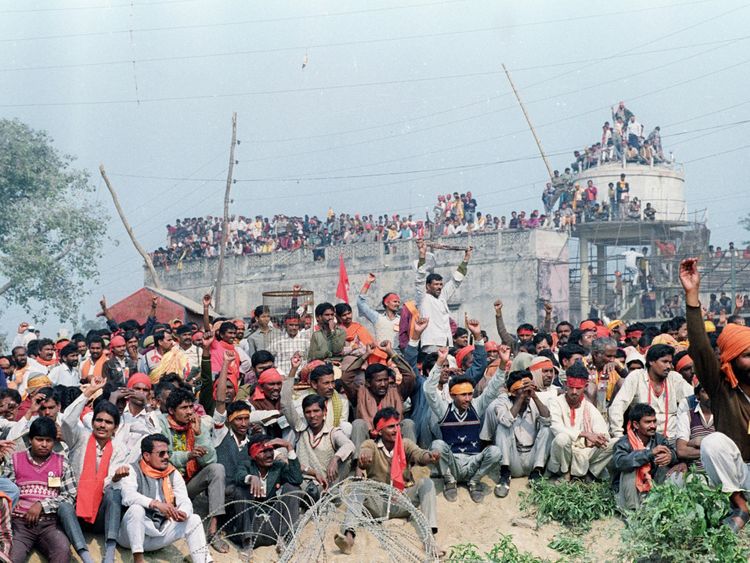
The policies and examples discussed above are just the highlighted and mainstream government policies that have attracted attention since Modi came into power.
There are hundreds of other such examples of government strategies that have fuelled religious (especially Islam), ethnic, and linguistic differences and divided the once highly diversified nation into a conservative and a Hindu nation. And burying the sectarian values, norms, and vision aspired by Nehru and the founding members of the Republic of India. Making India some personal property of Hindus and a dangerously threatening place for non-Hindus to live.
Analyzing the extent of the Hindutva Threat
All thanks to Narendra Modi and his Hindutva-driven aggressive policies and strategies, Hindutva, which until yesterday was an inter-state and national concern, has now grown to be a grave national and international security threat.
Akhand Bharat
The driving motive behind Modi’s and his RSS-funded administration’s decisions, domestically and regionally, is the accomplishment and establishment of Akhand Bharat (which marks the territories under the empire of Chandragupta Maurya in the 3rd century B.C.), covering today’s Afghanistan, Pakistan, India, Nepal, Bhutan, Sri Lanka, Bangladesh, Tibet, Myanmar, and Indonesia. They do not seek to wage war on any of the states to attain this vision.
As mentioned by Narendra Modi in 2012, before coming to office, Akhand Bharat “does not mean we wage war on any country… without war, through popular consent, it can happen.” “We call this Sanskritik Bharat (Cultural Bharat)” (Dhamijah, B.). They ought to weaken them internally so that it becomes easier for India to pull off this goal, and to weaken a state means meddling in its internal affairs, which India has constantly been doing since 2014.
The seizure of Kulbhushan Yadev and the entire RAW network in Balochistan, establishing tiers with militant organisations against the government, e.g., Bodu Bala Sena and Liberation Tigers of Tamil Eelam (LTTE) in Sri Lanka and 969 in Myanmar, forcing the Nepalese government to abandon the Federal Constitution in favour of a more Hindu Constitution and setting up fundamentalist fronts.
Ranabir Sena (R.S.) and Nepal Defence Army (NDA) to revive the monarchy and Hindi as the state language (which, however, they could not achieve), is a proof of how the Modi administration can fulfil their Hindutva vision of Akhand Bharat without having to wage war against any regional state, and also a proof of how Hindutva can damage South Asian peace and integration.
Hostile and Aggressive India’s Foreign Policy
In addition to this, scholars and analysts fear that with the rise in communal violence against minorities in India, transnational extremist groups, including Jihadis, IS, etc., can penetrate the Indian borders, take sides, and increase violence, which India can use as an accusation against Pakistan, justify any offensive action against her, and can, resultingly, endanger the situation in the region.
Another factor through which Modi can put the South Asian peace at stake is through his aggressive and expansionist foreign policy. Ideological factors drive the foreign policies of states. Under Modi’s authoritarian regime, Indian foreign policy has proved to be of an aggressive and offensive nature, and this has evoked severe security problems for India’s neighboring countries, especially Pakistan.
The reversal of Articles 370 and 35(A) has been the most belligerent step taken by the Modi government at the international level. Kashmir, a bone of contention and source of discord between the rival states ever since 1947, has been reshaped by the fascist Modi regime and could prove to be a source of armed conflict between the two nuclear states.
Adding to this, the continuous violation of ceasefire agreements on the LOC since 2014 (2158 in 2020 alone), the dramatized Pathankot attack in 2016, the pre-planned Pulwama incident in 2019, the detention of an Indian submarine by the Pakistan Navy in 2019, and the Balakot incident in 2019, which violated Pakistan’s space sovereignty, could have instigated a full-fledged nuclear war among both nations provided it was not a sensible and well-calculated response on behalf of Pakistan.
India’s foreign policy towards China is another example of how hostile and aggressive India’s foreign policy towards its regional neighbors has become under the Hindutva motive of ensuring Hindu supremacy in Asia. India is influencing the regional states either through economic, diplomatic, or military efforts to counter rising Chinese influence on BRI.
Change in India’s Nuclear Doctrine from NFU to FU to deter China; five severe standoffs between Indian and Chinese forces at the Line of Actual Control (LAC) since 2013; most recently at the Ladakh front, which was initiated by India herself, silent war of Indian and Chinese Navy in the Indian Ocean, confrontations in the South China Sea since 2014, India’s relationship with the US based on countering Chinese threat; are all the policies which depict an aggressive stance for China in Indian Foreign Policy to oppose its hegemonic rise and to ensure Hindu Hegemony in Asia.
Not just with Pakistan and China, which can be justified as being historic enemies, but India has gotten under its other neighbors’ skin as well, including deteriorating bilateral relations with Nepal due to their democratization process and putting up a complete blockade on Nepal in 2015 in the wake of ethnic tensions across the border.
India under Modi has also undermined Nepalese sovereignty over the disputed areas after the revocation of Article 370 in 2019 and included the border areas within its territory and started building infrastructure over it (the 80-km-long Himalayan Road passing through the disputed Kalapani region), fueling a mob of hatred and criticism from the Nepali government and people.
India’s relationship with Sri Lanka has been vandalized after an aggressive stance was taken by Modi-driven India to control Sri Lanka’s shift more towards China and its BRI Project (Energy Project and presence of submarines at Colombo Port), as compared to India and abandoning its projects (ECT Project).
Relationship with the Maldives is also at stake as an upswing against the Indian-influenced government policies has come under a cloud of criticism and anti-government rallies, which will force the government to re-evaluate and reassess its relationship with India, and result in India losing another loyal friend from the community.
Expansionist activities of India in the Sikkim and Assam Arunachal regions of Bhutan for easy access to the religious places in Tibet are putting the Bhutan-India years-long friendship in jeopardy. Due to harsh and Hindutva-driven foreign policies, India, which has long enjoyed Bhutanese support in every matter, is now facing criticism and condemnation from its closest friends among its neighbors.
All these foreign policy initiatives under Modi’s banner of “Neighbourhood First Policy” in its immediate neighborhoodneighborhood reflect how Indian leadership decisions are fuelled by hatred and antagonistic sentiments based on Hindutva ideology and how these decisions can put national, regional, and universal security at risk.
Hence, Hindutva is neither a national nor a regional issue. It has now transformed into a global issue, staking the risk of the entire world. Because, in the event of any full-fledged armed conflict between the regional powers (three of which are nuclear) because of the intruding and aggressive policies of Modi India, the repercussions of such a standoff would not remain limited to a region. They would be worldwide and uncontrollable.
Conclusion
Analysis
Analyzing the answers and given hypotheses to the research questions, one can conclude that the constructivist lens and perspective not only help you clearly understand and comprehend the Indian sentiments, their historic experiences, and their religious and cultural basis but also provide future insight regarding the threats and limits posed by them.
The in-depth scrutiny also proves the suggested hypotheses and multiplies the validity of the research paper. Hindu nationalism, which started as a means to unite the Hindu identity, has now transformed into a militant version that imposes the Hindu religion and lifestyle over other sects and minorities.
As much as it threatens the peace and stability of the country, it also threatens regional and global integration. The Modi administration and its hate-filled policies have reflected upon its citizens and the rest of the world regarding its identity goals and aims.
The RSS-vision-driven BJP is guiding Indian policies and is calling for trouble from its entire neighbourhood, be it China, Pakistan, Nepal, Bhutan, Sri Lanka, Bangladesh or Maldives. India’s fascist and aggressive foreign policies are altering its decades-old alliances into enemies for the sake of fulfilling its identity goals, and there is no stopping it.
India is not just harsh on its neighbours. It is not sparing its citizens, discriminating and alienating its non-Hindu population, changing its demographics, and bringing about abomination amongst the different communities. The introduction of Hindutva prone bills and policies, e.g., Gau Raksha bill, Love Jihad, setting up of military schools, legitimisation of right-wing militia Bajrang Dal, Anti-Conversion law, Citizenship Amendment Act, detention of critics, abrogation of 370 and 35(A) articles, subjugation of Muslims, Christians, Dalits etc.
It is a proof of the extent of insanity to which Indian leadership can go without, for once, taking into account its consequences even for their state.
The same feature India cherished for decades has become a liability today. If we assess the problem, there is no specific, well-defined framework for putting an end to it. Even constructivism suggests that states with subjective interests (identity-driven interests) do not stop until their objections are achieved.
In the case of Hindutva, the end goal is Hindu India (free of non-Hindus) and Hindu dominancy and expansion throughout the South Asian region. No one policy solution can bottle this up. The only way to halt the Hindutva madness is through native public opposition and the international community’s response.
The public must stand up to the tyrant rulers and not let Hindu extremism consume their diversity. The international media, too, should wake up from its dead sleep and compel India to destroy the peace and tranquillity of the extended region and the world. Otherwise, the implications would be too serious to cope with.
Implications
For India
- With Hindutva sentiments to make India a habitat for only Hindus, India will most probably lose its diversity in its culture, ethnicity, and religions, which it has celebrated since independence. Most Muslim, Christian and even Sikh communities shall either be forced to leave India through Hindu-centric laws or be targeted to such an extent unless they cease to exist or become as helpless as non-existent.
- India will soon fall into the pothole of civil unrest or terrorism amongst different ethnic and religious groups. It will cause non-state militias to penetrate its borders, and its image as the world’s largest democracy will soon be shattered.
- India will no longer remain a tolerable, multi-linguistic, secular state, instead will become a traditional, conservative, and ruthless Hindu state.
- India will continue its efforts to control and involve in the internal affairs of its neighbouring states, most specifically Pakistan, to get hold of these states politically, which will provoke serious consequences in terms of armed conflicts and even war.
- India’s aggressive behaviour towards its neighbouring states, including Pakistan, Maldives, Sri Lanka, Bangladesh, Bhutan, Nepal, etc., will make room for China to overshadow the Indian alliance for the states, as it has done with Pakistan, Sri Lanka, and the Maldives through BRI, and so, will ensure China’s hegemony and dominance in the South Asian region against the United States and India.
For South Asia
- South Asia will surely get into chaos and conflict if India does not stop its policies. India and Pakistan are more likely to get into an eternal arms race, and not only a convenient one but a nuclear arms race, with the constant threat to regional peace.
- India and China will surely face a head-off due to the fight for regional hegemonic status, and no such skirmish will be limited to conventional warfare.
- India and Pakistan will also face a blind alley in the Kashmir issue if India does not stop its atrocities, and a full-fledged war could likely break out between the two.
- In case of conflict between any two entities, the entire South Asian and Asian region will suffer, as the conflicting parties will not keep the fight within themselves but will be supported by different neighboring states and allies, putting world peace at stake.
Policy Recommendations
For South Asia
- The member states should revisit the SAARC organization and amend its failures and reflectivities on a priority basis so that the conflicts and disagreements between states are negotiated and addressed through proper communication channels rather than through border skirmishes and aggression.
- The member states should use SAARC or any other international platform to side with one another against an aggressor state, limit its hostile policies, and take collective action to restore regional peace.
- The member states should keep a neutral alignment policy with either state and not align completely with one state so that they are not obliged to follow others’ orders and can decide what is best for their people.
- The member states should never let things between them go to the extent of war. Instead, they should opt for reconciliatory measures to diffuse the tension and co-operate in times of crisis.
For India
- The Indian people should unanimously oppose the antagonistic Hindutva-driven policies of the political leadership. They should stand with one another, irrespective of who belongs to which religion or sect.
- The media should step down from its yellow journalism and perform the function it is meant to, i.e., spread awareness and criticize the policies meant to be criticized.
- Civil disobedience and noncompliance movements should be initiated if the government tries to reform its forefathers’ Constitutional guidelines and principles.
- They should remember the slogan “Unity in Diversity” and the theme it conveyed and keep their most treasured characteristics intact by not imposing the majority religion upon others. But letting the diversity and variegation of different religions, sects, cultures, ethnicities, and linguistics define the true beauty and reality of Indian society.
My name is Lyba Mobeen. I'm currently pursuing degree of BS-International Relations at Islamic University Islamabad.







